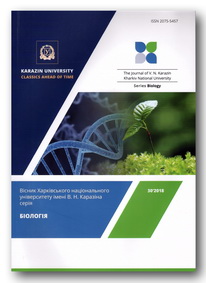Investigation of the flora of epigean bryobionta of the Olexandria Dendrological Park
Abstract
Species composition of epigeic bryophytes of the Olexandria Dendrological Park, located in the northeast of the Right-Bank forest-steppe of Ukraine, was studied. The research was conducted in 2017–2019. As a result, 40 species of 25 genera, 14 families, 7 orders, 2 classes, and 1 division were registered. A taxonomic analysis showed that the orders Hypnales (14 species), Pottiales (9 species) and Bryales (9 species) are represented best. The main families were as follows: Pottiaceae (9 species), Brachytheciaceae (7 species), Bryaceae (5 species), Amblystegiaceae and Mniaceae (4 species each). The most speciose were the genera Bryum (5 species), Brachythecium (4 species), Tortula (4 species) and Plagiomnium (3 species). Among the identified taxa, two species, (Barbula сonvoluta and Bryum rubens) are regionally rare in the Forest-Steppe zone of Ukraine. In the historical part of Olexandria, five species Ceratodon purpureus, Oxyrrhynchium hians, Hypnum cupressiforme, Atrichum undulatum, and Bryum moravicum were the most common epigean bryophytes. In the western part of the Dendropark, the prevalent species were Atrichum undulatum, Bryum moravicum, Oxyrrhynchium hians, Hypnum cupressiforme, Brachytheciastrum velutinum, and Hygroamblystegium varium, in the central part – Bryum moravicum, Hypnum cupressiforme, Ceratodon purpureus, and in the eastern part – Fissidens taxifolius, Fissidens viridulus, and Brachythecium rutabulum. Twenty species (50 % of the identified taxa) were obligate epigees while the other 20 species belonged to the facultative epigees. In 2018, a new species to the Dendropark’s bryoflora, Ephemerum minutissimum, was found in an oakery (locality 14). It grew there together with Dicranella heteromalla, Bryum rubens, Barbula convoluta, Ceratodon purpureus, Tortula acaulon, and Weissia brachycarpa. This is the second record of E. minutissimum from Ukraine. The highest number of epigeic moss species was registered in the central part of Olexandria (29 taxa). At present, the epigeic bryoflora of the Dendropark’s historical part comprises 44 % of its whole bryoflora (90 species).
Downloads
References
Balkovski B.Ye., Savostianov O.O. (1939). Materials for the bryoflora of Vinnitsa and Kamenets regions. III. Ukrainian Botanical Journal, 21–22, 299–305.
Boiko M.F. (2008a). А Checklist of the Bryobionta of Ukraine. Kherson: Ailant. 232 p.
Boiko M.F. (2008b). A Checklist of the Bryobionta of Ukraine (taxonomic review, superspecies taxa). Chornomorski Botanical Journal, 4(2), 151–160.
Boiko M.F. (2010). Red List of Bryobionta of Ukraine. Rare and endangered species of the Bryobionta of Ukraine. Kherson: Ailant. 112 р.
Boiko M.F. (2014). The Second Checklist of Bryobionta of Ukraine. Chornomorski Botanical Journal, 10(4), 427–487.
Ellis L.T., Aleffi M., Bączkiewicz A. et al. (2019). New national and regional bryophyte records, 60. Journal of Bryology, 41(3), 285–299. https://doi.org/10.1080/03736687.2019.1643117
Virchenko V.M. (1986). Bryophytes of the forest-steppe part of the Dnieper Upland. Kiev. 24 p.
Zerov D.K. (1939). A key of liverworts of the USSR. Kyiv, 1939. 152 p.
Zerov D.K. (1964). The flora of liverworts and sphagnum mosses of Ukraine. Kyiv. 356 p.
Authors retain copyright of their work and grant the journal the right of its first publication under the terms of the Creative Commons Attribution License 4.0 International (CC BY 4.0), that allows others to share the work with an acknowledgement of the work's authorship.




